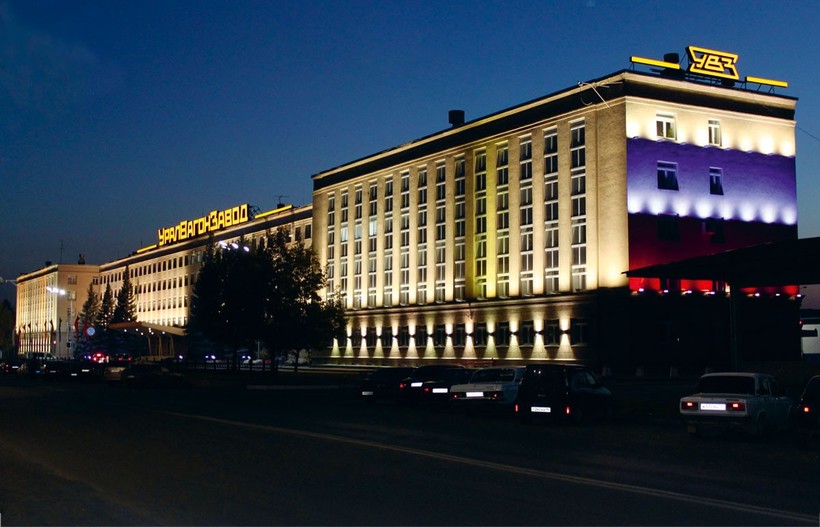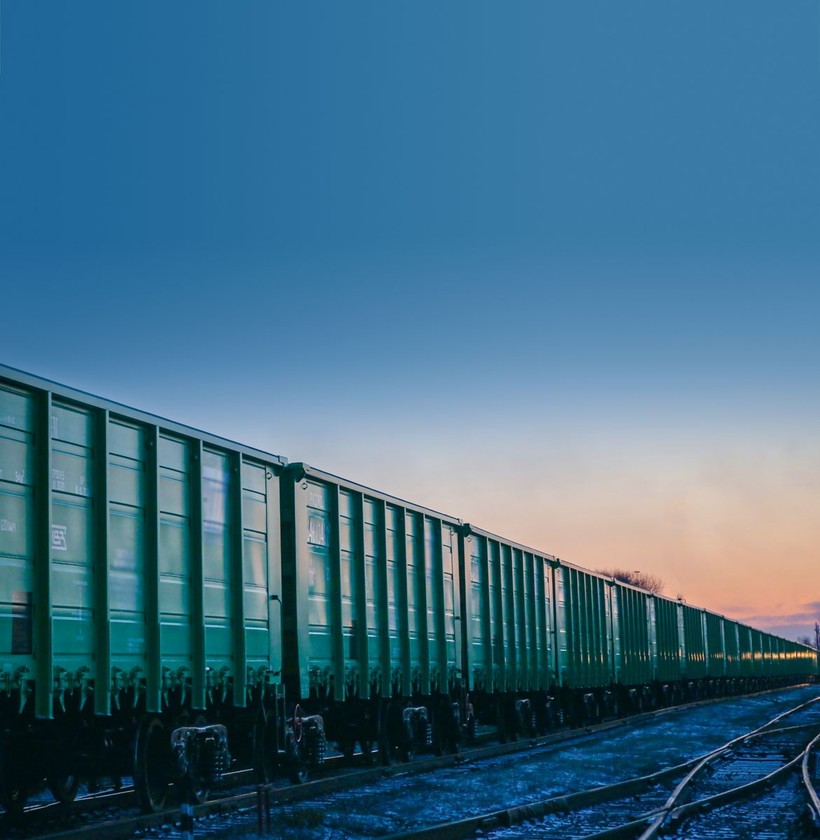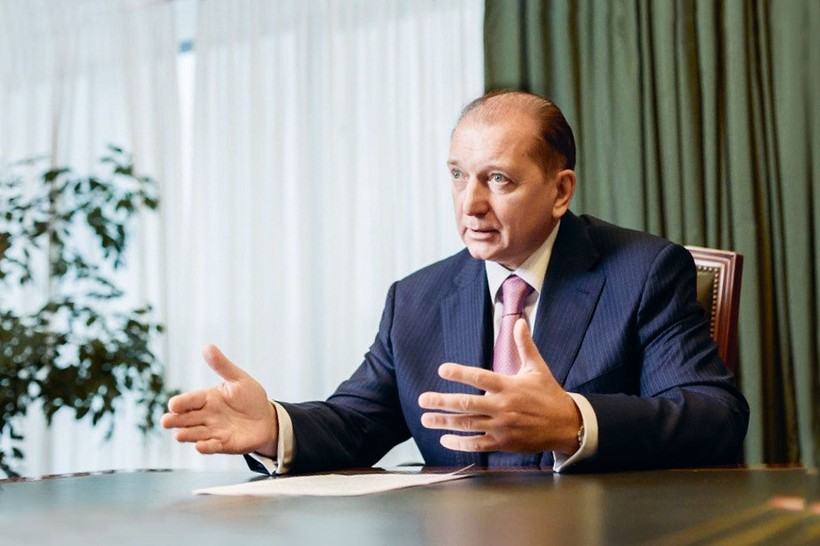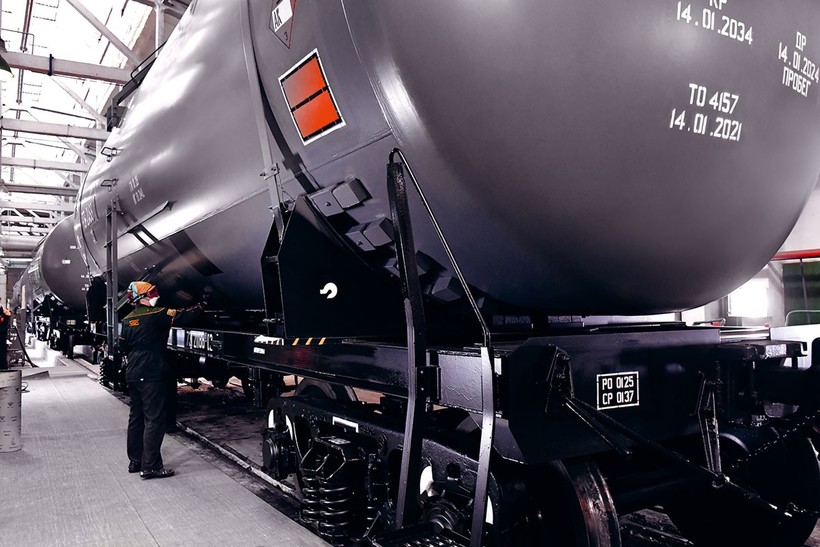Swinging Tracks
Structural oversupply coupled with low economic growth rate has created the conditions under which the Russian wagon-building industry is to exist in the coming years. To counteract the negative environment, the Uralvagonzavod freight wagon manufacturing company, part of Rostec, is targeting new market segments and changing the quality of their service by promoting full life-cycle contracts.

Changes on the Russian wagonbuilding market over the past decade and a
half (since the most recent railway transport
industry reform was launched) suggest an
analog y that is far from straight as an arrow. It
is more like a roller coaster or a swing, where
a change in position can be compared to the
fundamental change in the market environment
for transport companies and rolling stock
manufacturers.
According to the Institute for Natural
Monopolies Research (IPEM), 2011–2012 was an important milestone for the industry: there
was no longer an inventory of wagons and all
commercial transport operations had switched
over to a private wagon fleet. “At that time, the
rates for providing rolling stock were rising,
a lot of railway wagons were supplied to the
railway network, and manufacturers invested in
expanding their capacity to meet the demand,”
IPEM said.
That period favoured manufacturers in
what was essentially a seller’s market. Yet, by
2013–2014, the market situation had reversed.
Previous large-scale wagon purchases led to a
surplus of rolling stock. Rates of provision and
leading, as well as demand for new wagons, fell,
and manufacturers had to hastily cut and even
phase down production. As IPEM stated, the
market passed over to the buyers.
The dramatic decline in the industry forced
the government to intervene. In particular,
a government decree introduced mandatory
certification when extending the service life of
wagons in order to push operators to renew their
wagon fleet more actively and, since 2016, there
has been a de facto ban on operating most types
of rolling stock after the service life set by the
manufacturer expires.
In fact, the measure led to a massive writeoff of outdated rolling stock of around 215,000
wagons over two years, supporting the demand
for new freight wagons.
Again, for a short time,
there was a seller’s market. Manufacturers of
freight wagons actively increased supplies, which
resulted in an increase in the number of freight
wagons in Russia by more than 55,000, up to
1.168 million, which exceeded the 2012 figure.
The same year marked an absolute production
volume record, with a total of 79,600 freight
wagons of various modifications produced in
Russia.
However, by the second half of 2019,
the market swing was reversed. “High growth
rates of the fleet on the railway infrastructure, combined with other negative factors, including
a significant drop in global coal prices, created a
new environment on the railway transportation
market: the rates for provision and leading fell
for certain types of rolling stock, including open
wagons,” explains IPEM.

TRAFFIC JAM ON THE NETWORK
To some extent, the dramatic decline in
economic activity last spring and summer
following the onset of the coronavirus pandemic
only reinforced the trends already emerging. No
disaster occurred with traffic volumes. Last year,
Russian Railways freight turnover, including
the empty run of wagons, fell by only 2.6%, to
3,220.6 billion tonne-kilometres. The network
load fell by about the same amount – 2.7%, to
1.234 billion tonnes. Loading of oil, petroleum
products and ferrous metals fell the most, by
about 10% year-on-year, to 208.8 million and
66.4 million tonnes, respectively. In contrast,
grain shipments rose the most – by 28.7%, to
27.9 million tonnes.
While transportation was almost unaffected by
the pandemic, railway rolling stock manufacturers
were more sensitive, with a decrease of around
a third in deliveries to the market.
According
to Infoline, in 2020, production of wagons by
Russian manufacturers fell by 28.7%, to 56,200
units. This included wagons supplied to Russia and the ‘1520 space-friendly’ countries, with
a track gauge of 1520 mm, as in Russia. The
most massive segment, that of open wagons,
was affected most, with a 42.2% reduction
in deliveries owing to a persistent significant
surplus in supply, of 21,800 units. Purchases of
fitting platforms for the transportation of largetonnage containers fell by 21.3% to 11,900 units;
grain carriers by 21.9% to 7,000 units, given that
22,900 freight wagons of various types were
decommissioned as planned during the year.
Both leaders of the Russian industry showed
signi
cantly reduced production. United Wagon
Company (UWC) shipped 16,600 wagons to
customers in Russia and the 1520 space, which is
20% less than in 2019. Uralvagonzavod (UVZ)
reduced production by about 40%, to 10,700 units.
Without ignoring the obvious problems,
UVZ says they were nevertheless able to
achieve their corporate objectives, despite the
negative market environment. “Last year, the
plant’s revenues from sales of civilian products
amounted to 40 billion rubles. Last year’s plan
was fully implemented, in spite of the objectively unfavourable circumstances caused by the
pandemic and oversaturation of the Russian
market for open wagons,” says Boris Myagkov,
Deputy General Director of UVZ.
According to the top manager of UVZ’s civilian
product line, since last spring, the Russian wagon
eet has been over
owing: there are about 1.2 million
wagons in the network, while the surplus of open
wagons alone is estimated at 70,000–100,000 units.
At the same time, the share of recently produced
rolling stock is still high.
“So, we do not expect the
situation from 2015 to recur, when a service life
extension procedure for wagons was enforced and
rental rates rose once the outdated wagon had
been written off,” explains Myagkov.
Yet, the search for alternative industry support
measures is still under way. Last summer, UVZ
suggested a trade-in programme launch initiative
to the government. Under the proposal, an owner
would receive one new innovative gondola wagon
for three open wagons with a residual service life
of 3-6 years. The total cost would be reimbursed
in equal shares by a government subsidy and the
residual value of the scrap.

“In 2020, the Russian and global economies faced serious challenges, and
unified efforts by the government and business will be required to overcome
them. The wagon building industry must definitely take over as one of the
key drivers of economic growth. The sector features a high level of internal
cooperation and a strong ability to leverage related industries. It is currently
of particular importance to respond promptly to industry risk factors, and
develop and promote effective measures in a timely fashion to adapt to volatile
market conditions. It is also vital to drill specifically into ways to boost exports.
Reaching new heights in wagon building, it is important to try new approaches,
as well as to focus on exchanging technology and experience that is valuable to
all parties involved.”
VLADIMIR ARTYAKOV,
Senior Deputy General Director at Rostec State Corp
It is estimated that the launch of the
programme will increase the write-off of
gondola wagons by up to 17,000–26,000 units a
year through 2025. By then, the surplus should
be reduced to about 24,000 pieces, while
demand for innovative wagons should go up by
a third.
In November last year, a special meeting
with Deputy Prime Minister Yuri Borisov in
attendance and other measures to support the
industry were on the agenda. Yet, no specific
decisions have been made since then.
One way or another, UVZ representatives
insist there is a need to further update the
freight rolling stock to expand the capabilities
of the current railway infrastructure. “We still
believe that new wagons built on outdated
bogies create congestion in the network. So, we
believe that restrictive measures with respect
to some of the least efficient types of rolling
stock are long overdue. We hope for a positive
resolution of this matter,” notes Myagkov.
Such measures would provide considerable
support to manufacturers of modern technology, including UVZ, where almost half of sales are
of innovative wagons of various modifications –
hoppers, dump wagons, platforms and tanks. In
March, the company shipped to the customer
the 40,000th innovative 12-196-02 open wagon
on innovative bogies with an increased axle
load.

THE HIGH LOADING LEVEL
The stake on innovative technology is an
opportunity to earn and develop even given
the surplus supply of railway equipment, which
will remain in the coming years, as the company
itself admits. “The surplus does, indeed, exists
and the natural retirement of wagons at the
end of their service life will be minimal in the
next few years. In this situation, it is difficult
to expect large orders, so we are focusing on
production of the most efficient equipment for
the owner in terms of economic parameters –
for example, the ability to carry more freight,”
says Myagkov.
Such equipment will be in demand and will
oust outdated wagon models from circulation
as being uncompetitive on certain routes. Even
with a surplus, the demand for such equipment
will still be there.”
Despite all the market complexities, the
company has coped with the current challenges
and has secured foundations for the future.
“Since last September, when I was entrusted
with production capacity load matters, we have
produced more than 10,000 wagons and signed
a number of new contracts. I estimate the
current load level as high,” notes Myagkov.
In total, the company expects to produce
15,000 open wagons this year, 43% more than
last year. “We believe that open wagons will
always be in demand, and we are able to sell
6,000–8,000 units in any market conditions,
as replacing inefficient old-generation wagons
with new ones is inevitable.”
At the same time, the company does not intend
to confine itself to traditional markets; it is getting
ready to expand into promising new segments.
One of UVZ’s priorities is to re-orientate
some production capacity to fitting platforms
for containers. “The market has now shifted
considerably towards container transportation,
some even want to use containers to transport coal,” explains Myagkov, “so we expect growth
in demand for platforms from Russian operators
in the coming years. Unlike the market for open
wagons, which will not recover before 2030.”
Implementation of big transport infrastructure
projects in Russia planned for the next few years
could also drive the demand for rolling stock.
These include plans to modernise the TransSiberian Railway. “By all means, expansion of the
carrying capacity on the Transsib will play a role.
In this case, we expect an increase in coal traffic
and in the demand for open wagons,” explains
Myagkov.
Although UVZ does not expect explosive
growth of its business, it is counting on
opportunities to develop and produce new
equipment. In particular, expecting an increase
in container traffic, the company intends to
stake on refrigerated containers. UVZ are
preparing for serial production of them right
now.
“The Russian market has serious potential
for refrigerated containers, owing to the urgent
need to transport fishery products from the Far
East,” Myagkov says.
The company has not yet mentioned the
possible target demand values for this type of
equipment. However, they say the market is
still far from saturated: while there are about
2 million refrigerated containers in operation
globally, in Russia there are no more than 5,000.
Finally, in addition to revising its product
portfolio, the company is modifying its approach
to creating the end product for operators,
particularly by promoting their products on
the market through full lifecycle contracts.
Depending on the conditions, the wagons are
sold with maintenance and repair obligations
throughout their entire service life.










